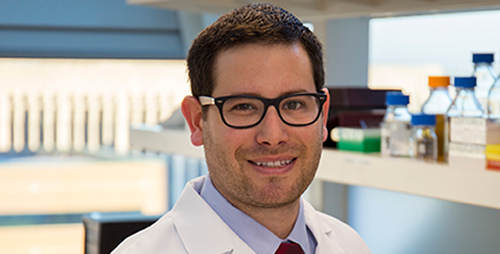
GRAND RAPIDS, Mich. (Sept. 7, 2016) — Scientists may be closer to answering a long-standing question in biology — how do the components of cells’ molecular machinery work together to transmit vital gene regulatory information from one cell generation to the next?
New findings published in eLife draw connections between some of these pieces, revealing an extensive web of molecular interactions that may ultimately inform the development of new epigenetic drugs for cancer and other diseases. Specifically, the study reveals a mechanism that helps explain how dividing cells pass patterns of epigenetic information called methyl tags to their daughter cells, a crucial part of regulating gene expression across cell generations.
Epigenetic tags help tell genes — stretches of DNA that act as biological instruction manuals — when to switch “on” and “off,” ultimately determining cell type and function. DNA methylation, or the addition of methyl tags to DNA, is one of the most well-studied epigenetic signals; errors in this process are commonly found in cancer.
“Many of the key players orchestrating DNA methylation had previously been characterized, but what we didn’t fully realize before this study is that they all work together in an elegant way,” said Scott Rothbart, Ph.D., assistant professor at Van Andel Research Institute (VARI) and the study’s senior author. “These new insights into the complexities of epigenetic regulation are contributing to our basic understanding of this process in human health and disease and gives us new vision for how to go about targeting errors in DNA methylation with innovative drug therapies.”
The findings center on a protein called UHRF1, a guardian of the cell’s epigenetic information that can recognize patterns of epigenetic tags and promote the addition of new ones. These “reading” and “writing” activities of UHRF1 are well understood on their own but until now, scientists didn’t know exactly how or even if these UHRF1 activities worked together. Rothbart’s team, along with collaborators from University of North Carolina at Chapel Hill, University of Washington and University of Toronto, tackled this problem by asking two questions — how does UHRF1 get to where it needs to be? And once it’s there, what does it do?
Here’s what they found — during cell division, UHRF1 recognizes newly copied DNA at sites that are missing methyl tags. At the same time, it also recognizes a protein associated with DNA called histone H3 and attaches another small protein called ubiquitin on that histone. This ubiquitin protein acts as a molecular flag, signaling to another protein called a DNA methylation enzyme that a methyl tag is needed there. The group discovered that ubiquitin attachment on the histone is promoted by the pre-existing pattern of epigenetic signals recognized by UHRF1. This is the first time an epigenetic signal has been shown to impact ubiquitylation and connects the patterns of epigenetic information in a new way.
“While the functions of the individual parts of UHRF1 were already known, we didn’t appreciate the interdependence of these functions in adding ubiquitin to histones,” said Joe Harrison, Ph.D., a postdoctoral fellow in the Kuhlman Laboratory at UNC and the paper’s first author. “This exquisite regulation of an ubiquitin ligase has not been previously described and is very exciting for the field of ubiqutin biology.”
Drugs that impact DNA methylation are increasingly a target for drug development; in fact, several of these therapies are already in clinical use for certain cancers. With this new knowledge, the next step, Rothbart says, is to develop robust screening methods to find compounds that correct errors in this process.
###
Rothbart’s work was funded in part by Van Andel Research Institute and the National Institutes of Health. For a full funding statement, please see the publication.
Harrison J, Cornett E, Goldfarb D, DaRosa P, Li Z, Yan F, Dickson B, Guo A, Cantu D, Kaustov L, Brown P, Arrowsmith C, Klevit R, Erie D, Major B, Krajewski K, Kulhman B, Strahl B, Rothbart S. 2016. Hemi-methylated DNA regulates DN methylation inheritance through allosteric activation of H3 ubiquitylation for UHRF1. eLife.
ABOUT VAN ANDEL RESEARCH INSTITUTE
Van Andel Institute (VAI) is an independent nonprofit biomedical research and science education organization committed to improving the health and enhancing the lives of current and future generations. Established by Jay and Betty Van Andel in 1996 in Grand Rapids, Michigan, VAI has grown into a premier research and educational institution that supports the work of more than 360 scientists, educators and staff. Van Andel Research Institute (VARI), VAI’s research division, is dedicated to determining the epigenetic, genetic, molecular and cellular origins of cancer, Parkinson’s and other diseases and translating those findings into effective therapies. The Institute’s scientists work in onsite laboratories and participate in collaborative partnerships that span the globe. Learn more about Van Andel Institute or donate by visiting http://www.vai.org. 100% To Research, Discovery & Hope®
Media Contact
Beth Hinshaw Hall
[email protected]
616-234-5519
Homepage – Van Andel Institute (VAI)
The post The whole of epigenetic regulation may be greater than the sum of its parts appeared first on Scienmag.





